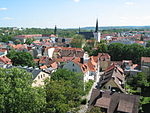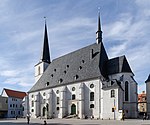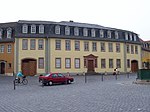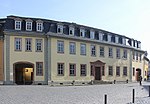Schloss Weimar

Schloss Weimar is a Schloss (palace) in Weimar, Thuringia, Germany. It is now called Stadtschloss to distinguish it from other palaces in and around Weimar. It was the residence of the dukes of Saxe-Weimar and Eisenach, and has also been called Residenzschloss. Names in English include Palace at Weimar, Grand Ducal Palace, City Palace and City Castle. The building is located at the north end of the town's park along the Ilm river, Park an der Ilm. It forms part of the World Heritage Site "Classical Weimar", along with other sites associated with Weimar's importance as a cultural hub during the late 18th and 19th centuries.In history, it was often destroyed by fire. The Baroque palace from the 17th century, with the church Schlosskirche where a number of works by Johann Sebastian Bach were premiered, was replaced by a Neoclassical structure after a fire in 1774. Four rooms were dedicated to the memory of poets who worked in Weimar, Johann Wolfgang von Goethe, Johann Gottfried Herder, Friedrich Schiller and Christoph Martin Wieland. From 1923, the building has housed the Schlossmuseum, a museum with a focus on paintings of the 15th and 16th centuries and works of art related to Weimar, a cultural centre.
Excerpt from the Wikipedia article Schloss Weimar (License: CC BY-SA 3.0, Authors, Images).Schloss Weimar
Burgplatz,
Geographical coordinates (GPS) Address External links Nearby Places Show on map
Geographical coordinates (GPS)
| Latitude | Longitude |
|---|---|
| N 50.9803 ° | E 11.3322 ° |
Address
Stadtschloss
Burgplatz 4
99423 , Altstadt
Thuringia, Germany
Open on Google Maps











